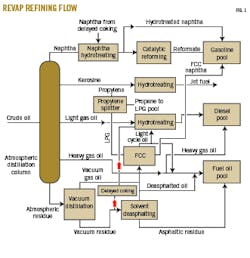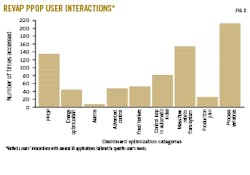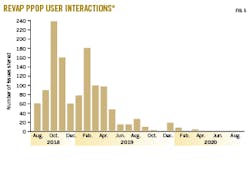Brazilian refinery digital transformation focuses on people over process
Carina Pederiva Laidens
Marcio Wagner da Silva
Petróleo Brasileiro SA
São José dos Campos, Brazil
Reduced demand for finished petroleum products caused by the coronavirus (COVID-19) pandemic has created a new competitive environment for global refiners in which agility and efficiency have become fundamental to sustaining the economic viability of operations. This new normal is prompting many refiners to rapidly embrace business and digitalization strategies that will enable greater resilience and flexibility in the uncertain times ahead. While achieving a digital transformation is essential to achieving these goals, the undertaking requires careful consideration, thoughtful planning, and a lasting commitment to implementing what works best for one’s refinery.
In 2018, Petróleo Brasileiro SA (Petrobras) started a digital transformation program dedicated to integration of management and process data at its 252,000-b/d Refinaria Henrique Lage (REVAP) refinery in São José dos Campos, São Paulo, Brazil (Fig. 1). Designed to capture and maximize use of existing operating and processing data to help improve future refinery operations, the digital transformation program resulted in a series of projects to ensure safer, more reliable, and more profitable operations, as well as enhancing refinery processes and improving compliance with production planning (OGJ, June 1, 2020, p. 35).
While REVAP’s ongoing digital transformation program has enabled the refinery to enhance interaction between departments and expedite the flow of information to make more informed business decisions, these benefits did not occur overnight. No single technology provided a magical shortcut because, as Petrobras discovered, a vital factor in implementing and executing an effective digital transformation program is balancing technologies with people.
This article presents the six most important lessons REVAP has learned so far from its experiences beginning and—even more importantly—sustaining digital transformation programs in the refining space.
People, not software
Digital transformation programs in a refinery often begin by meeting with software vendors. This is done in an effort to find simple solutions to complex problems. But focusing on software alone does not ensure a successful program. A focus on technology and software needs may be appropriate during a project’s initial stages, but true digital transformation is about people, not software.
Petrobras understood ahead of implementing REVAP’s digital transformation program that it had to find a way to engage technology and management staff in the process, from the beginning stages of planning through project execution. To do so, the company created small, interdepartmental groups to prepare and educate staff regarding the digital transformation, enabling each team member to become comfortable with and take ownership of her or his part of the process.
While broadening and changing staff mindsets can be difficult—especially in the refining industry, where departments traditionally have worked in isolation of one another—the benefits are worth the time and effort invested. As staff across different departments became more comfortable with program goals and their individual roles in achieving them, their willingness and enthusiasm to collaborate across teams increased. Honed by focusing on corporate culture rather than technology and software applications, nurturing this cooperative spirit in staff created the means necessary to analyze, integrate, and convert data mined by software solutions into actionable projects.
When considering how to begin a digital transformation, remember digital transformation is not a technological event as much as it is a transformation of culture. If your company has internal programs dedicated to developing corporate culture, take advantage of them at the onset. If not, create smaller interdepartmental groups to acclimate staff to the objectives you intend to achieve with the program so that each team member finds—and can take ownership of—her or his function in helping to achieve those goals.
Existing problems
While the attraction of immediately trying out the latest, state-of-the-art software and technology offerings available in the digital transformation space to identify operational gaps, recommend quick solutions, and instantly transform and improve the entirety of plant operations is tempting, no single solution—regardless of its sophistication—can accomplish this.
The easiest way to sell your project to both management and staff is by illustrating the problems implementation of a digital transformation program could help solve, or at least minimize.
Rather than focusing on uncovering and resolving unknown issues, look at smaller, routine problems with which you and your colleagues are already familiar. This is particularly important early in the process because you will need prompt, positive outcomes to persuade both team members and management that undertaking the program is worth the required time and commitment. The best way to motivate staff and leadership at the outset is by solving problems everyone knows exist.
Upon undertaking the digital transformation program—which primarily sought to integrate the refinery’s existing management and processing data into a single, unique database—REVAP developed several interactive business intelligence (BI) applications to consolidate input from its interdepartmental teams. The BI applications were then combined in an optimization and production prioritization panel (PPOP) to make aggregated data available for use as a digital visualization tool by all teams (Fig. 2). While the PPOP presented the same information to all teams in a similar view, individual users were able to seek and make use of the data in ways that more directly impacted their own routines. This enabled readily identifiable and existing problems to be solved more quickly, encouraging both staff members and management that the digital transformation initiative was yielding tangible, beneficial results.
Expectations, situations
Digital transformation campaigns often encourage program proponents to “think big, start small, and move fast.” While thinking big and starting small are sound and readily achievable aims in shaping digital transformations at any company, the recommendation to move fast presents greater challenges to larger, more traditional companies such as Petrobras than it will to smaller or newer companies, especially those born during this age of digitalization.
In large, older companies, existing development teams devoted solely to digital transformation plans are rare, as is the freedom to create squads or departments focused on merging collective knowledge to accelerate the digitalization process. Instead, the process must take place within the company’s established organizational structure, which usually includes an already overworked and oftentimes inaccessible information technology (IT) department.
Cooperation from your company’s IT department on the digital transformation journey is crucial but sometimes difficult to gain, especially in larger legacy companies where demands on IT staff are greater. Just as you must convince management your proposed digitalization plans merit investing the personnel and costs required to execute the program, you must persuade IT that the endeavor is worth allocating its time and resources to help realize.
An effective approach to garner IT’s early participation is to begin with a small, simple project on which you can involve at least one member of the IT staff. Work with her or him to develop the project and prioritize it for just a part of the IT team in a way that does not impede on their other duties. As you develop this relationship with the department and share positive outcomes of its work on your project, you will gradually demonstrate that effort spent on the transformation program will not be wasted. It may require additional time to establish the trust and assurance necessary for wider IT-department involvement, but it will come, particularly when initial activities result in cost savings for the company.
One great advantage of REVAP’s program implementation was its creation of the PPOP to function as a single database for guiding future operational decision-making at the site. Because of the relationship the digital transformation team nurtured with IT over time via a series of smaller BI application projects, the refinery was able to create the larger database internally. As a result of this collaboration, REVAP eliminated any need to purchase additional software or licenses, reducing the program’s overall implementation cost.
A vital lesson from REVAP’s transformational journey to date is an understanding that digitalization is not a one-size-fits-all undertaking. While time will always be of the essence in the refining sector and swift implementation with quick payoffs are worthy goals, establishing realistic expectations—based on your company’s unique circumstances—for your transformation team, management, and cooperating departments can be a decisive factor in maintaining the momentum and cross-company participation required to achieve the program’s long-term—and likely most important—objectives.
Failures
No matter how well-planned or organized it may be, every digital transformation presents obstacles. While many advocate a fail-fast approach (in which teams are urged to execute a proposed strategy, adopt it if it works, and quickly discard or move on from it without consequence should it fail), this concept requires a psychological level of safety not typically present in older, more traditional companies.
Creating an environment in which team members are encouraged to try out new ideas and allowed to let those ideas fail for the sake of enabling future successes is possible, but—again—requires effecting changes in the company’s broader corporate culture. This can take time—even years—to fully accomplish.
Instead, split individual projects into smaller parts across teams so that no single team or individual absorbs the full impact or consequence when one of these projects proves unsuccessful. Moreover, when a project does fail, be prepared to reassure the teams and individuals involved that failure is a necessary part of the digitalization process. Proving that a strategy or approach does not work is as important to the program as validating those that do.
Leadership engagement
Management sponsorship is important for approval and funding of a digital transformation program, but mere sponsorship is not enough. The way leadership uses the results and continues to promote the company’s digital transformation are pivotal motivators in determining how committed the various teams and individuals involved in the initial stages of the program remain.
For example, during initial implementation of REVAP’s transformation program, use of the PPOP visualization tool was mandatory at leadership meetings. Even if all the information contributed by different teams was not used at these management meetings, the fact that members of the various teams knew the PPOP was an active part of these meetings encouraged frequent and detailed contributions to and interaction with the tool. This interaction led to a great information exchange about different processes and initiatives under way as part of the program.
As the program evolved and became more established, however, PPOP became less integral to these management meetings. The diminished engagement with PPOP by leadership, in turn, discouraged individual users from interacting as frequently with the tool, resulting in a dramatic decrease in the flow of information from various program teams. Once leadership deemphasized use of PPOP, it became difficult to convince other users of the tool’s ongoing importance.
Fig. 3 shows how often users interacted with the PPOP tool from initial stages of the program to the present.
While ongoing engagement of leadership in the transformation is critical to overall staff motivation, it more importantly ensures the future direction and longevity of the digitalization program. The key to a program’s continued success is to actively involve all parties from the beginning, keeping them engaged with program tools throughout implementation, and following implementation, fostering ongoing engagement with these tools by highlighting and acknowledging benefits achieved—and still achievable—as a result of program initiatives.
The unplanned
Regardless of the program’s size or scope, even the best-laid plans are fraught with the unexpected. Plan on disruptions, problems, and creating an environment of flexibility, in which every program participant is well-prepared to adopt approaches and processes to address whatever surprises may arise.
Each project increases an organization’s agility, experience, and know-how, increasing profitability and productivity. These rewards might not be reached in full right away but discovering the untapped potential present in the vast amounts of information on hand produces incremental benefits each time it occurs.
Bibliography
Campbell, J.D., Jardine, A.K.S., and McGlynn, J., Fundamentals of Petroleum Refining, 2nd ed., CRC Press, Boca Raton, Fla., 2011.
Cann, G. and Goydan, R., Bits, Bytes and Barrels—The Digital Transformation of Oil and Gas, 1st ed., MADCann Press, 2019.
Wilson, L., Lean Refining—How to Improve Performance in the Oil Industry, 1st ed., Industrial Press, South Norwalk, Conn., 2017.
Authors
Carina Pederiva Laidens ([email protected]) is a process engineer and production manager at Petróleo Brasileiro SA’s Refinaria Henrique Lage (REVAP) refinery in São José dos Campos, São Paulo, Brazil, with over 10 years’ experience as a downstream processing engineer focusing in process feasibility and optimization studies, process safety improvements, and more recently, industrial automation and IoT. She holds a BS (2004) in chemical engineering from Universidade Federal do Rio Grande do Sul, Porto Alegre, and an MBA (2020) in digital transformation from Pontifícia Universidade Católica do Rio Grande do Sul, Porto Alegre.
Marcio Wagner da Silva ([email protected]) is a process engineer and production manager at Petróleo Brasileiro SA’s Refinaria Henrique Lage (REVAP) refinery in São José dos Campos, São Paulo, Brazil. With a focus on crude oil refining, da Silva has extensive experience in research, design, and construction, as well as developing and coordinating projects for operational improvements and debottlenecking bottom-of-the-barrel units. He holds a BS (2004) in chemical engineering from Universidade Estadual de Maringá, Paraná, an MBA (2006) in project management from Universidade Federal do Rio de Janeiro, and a PhD (2010) in chemical engineering from Universidade Estadual de Campinas, São Paulo. He is certified in business and finance by Fundação Getulio Vargas.


